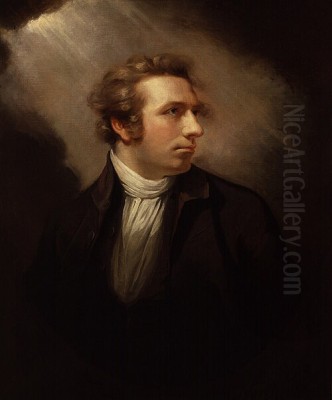
Johann Henry Fuseli, born Johann Heinrich Füssli in Zurich, Switzerland, in 1741, stands as a unique and pivotal figure in the landscape of European art history. Spanning the late Neoclassical and burgeoning Romantic periods, Fuseli carved a niche for himself with his highly imaginative, often unsettling, and profoundly influential body of work. Though Swiss by birth, he spent the majority of his prolific career in Britain, becoming a prominent member of London's artistic establishment. As a painter, draughtsman, and insightful art critic, Fuseli delved into the realms of literature, mythology, and the darker corners of the human psyche, leaving behind a legacy that continues to fascinate and inspire. His journey from a theologian-in-training to a celebrated, albeit controversial, artist is a testament to his singular vision and unwavering dedication to his craft.
Early Life and Education in Zurich
Johann Heinrich Füssli entered the world in Zurich on February 7, 1741. He was born into a family already steeped in the arts; his father, Johann Caspar Füssli, was a painter of portraits and landscapes, as well as a writer on art. His mother was Anna Elisabeth Waser. This environment undoubtedly nurtured his early inclinations, although his path towards an artistic career was not straightforward. His father, perhaps wishing a more stable profession for his son, directed him towards the clergy.
Fuseli received a thorough classical education at the Collegium Carolinum in Zurich, where he immersed himself in classical literature and languages. This grounding in the classics would profoundly inform his later artistic subjects. During his studies, he formed a close and lasting friendship with Johann Kaspar Lavater, the future poet and physiognomist. Fuseli did follow his father's initial wishes, studying theology and even being ordained as a Zwinglian minister in 1761. However, his passion lay elsewhere, and he never truly pursued a clerical career.
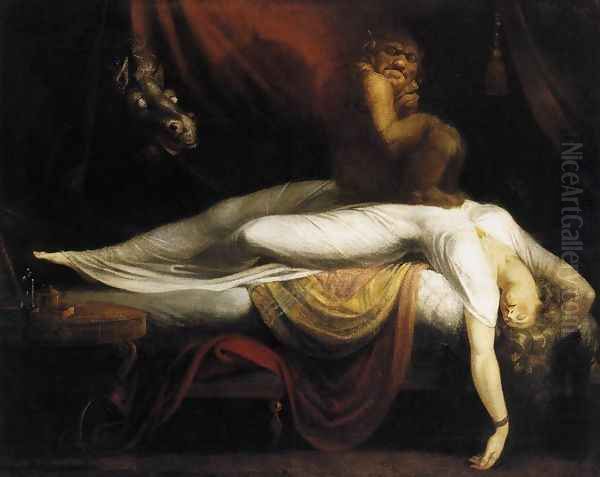
His time in Zurich was cut short by a youthful act of righteous indignation. Alongside his friend Lavater, Fuseli publicly exposed a powerful local magistrate whose family held significant influence. While their cause was just, the repercussions forced both young men to leave Zurich in 1763. This event marked a turning point, setting Fuseli on a path that would lead him away from Switzerland and towards the wider European stage, ultimately allowing his artistic talents to flourish. Even in his youth, Fuseli reportedly practiced drawing in secret, sometimes by candlelight, suggesting an early, almost clandestine devotion to the visual arts that ran counter to his prescribed theological path.
The Journey to Art: London and Reynolds
After leaving Zurich, Fuseli traveled through Germany, where he was exposed to the burgeoning ideas of the Sturm und Drang movement, which resonated with his own dramatic sensibilities. His linguistic skills and literary knowledge initially served him well. In 1764, upon the recommendation of Sir Andrew Mitchell, the British ambassador to Prussia whom he had met, Fuseli traveled to London. Initially, he supported himself through translation work and writing. He translated works from German, French, and Italian, including Johann Joachim Winckelmann's influential "Reflections on the Painting and Sculpture of the Greeks," making key texts of Neoclassical art theory available to an English audience.
His literary connections brought him into contact with prominent figures in London's cultural scene. However, a pivotal encounter occurred when he met Sir Joshua Reynolds, the preeminent portrait painter and first President of the Royal Academy of Arts. Fuseli showed Reynolds his drawings, and the esteemed artist was deeply impressed by the power and originality of the young Swiss's work. Reynolds strongly encouraged Fuseli to abandon his literary pursuits and dedicate himself fully to painting, advising him that he had the potential to become a significant artist.
This encouragement from such a respected figure was decisive. Fuseli, likely already harbouring artistic ambitions, took Reynolds' advice to heart. He recognized that to truly master the art form, particularly the historical and mythological subjects that fascinated him, he needed direct exposure to the masterpieces of the past. This realization prompted his decision to travel to Italy, the cradle of the Renaissance and repository of classical antiquity. His early years in London, marked by translation and the crucial endorsement of Reynolds, set the stage for his artistic transformation. He also moved in circles that included figures like the famous actor David Garrick.
Roman Sojourn: Influence and Development
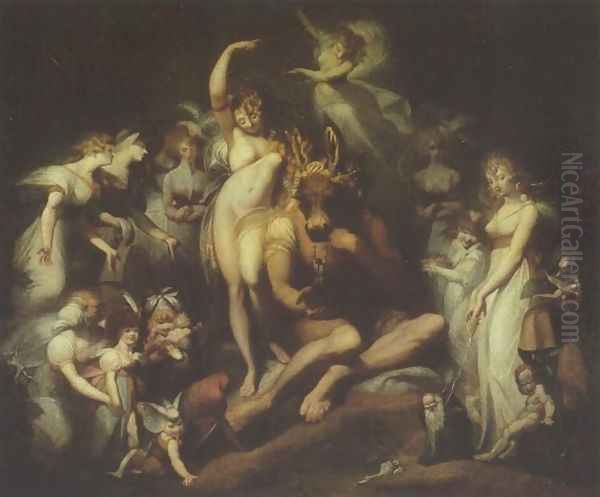
In 1770, Fuseli embarked on his journey to Italy, spending approximately eight years there, primarily in Rome. This period was transformative, profoundly shaping his artistic style and thematic concerns. In Rome, he immersed himself in the study of classical antiquity, frequenting the ruins and collections of ancient sculpture. The heroic forms and dramatic poses of Roman statuary deeply impressed him, influencing his own approach to depicting the human figure.
Even more significant was his encounter with the art of Michelangelo. Fuseli was overwhelmed by the power, dynamism, and anatomical mastery displayed in Michelangelo's frescoes in the Sistine Chapel. The "terribilità" – the awesome might and emotional intensity – of Michelangelo's figures resonated strongly with Fuseli's own temperament. He spent countless hours studying and sketching these works, absorbing lessons in dramatic composition, muscular anatomy, and the expressive potential of the human form. This influence is palpable throughout his mature work, seen in his often exaggerated musculature and contorted poses.
During his time in Rome, Fuseli largely eschewed painting in favour of drawing, producing hundreds of sketches inspired by classical art, Michelangelo, and literary themes. He began exploring subjects from Homer, Dante, and Shakespeare, developing his characteristic style marked by strong linearity, dramatic chiaroscuro, and a focus on moments of intense psychological or physical drama. He associated with other artists in Rome, including the Scottish painter Alexander Runciman and the Swedish sculptor Johan Tobias Sergel. He also connected with fellow British artists studying in Rome, such as George Romney, James Northcote, and the sculptor Thomas Banks, forming part of a vibrant expatriate artistic community. His Roman years were crucial for consolidating his artistic identity and technical skills.
Return to London and Rise to Prominence: The Nightmare
Fuseli returned to London in 1779, his artistic vision solidified and his technical abilities honed by his years in Italy. He arrived back armed with a portfolio of powerful drawings and a style that was distinctively his own – a potent blend of Neoclassical learning, Mannerist elongation, Michelangelesque power, and a burgeoning Romantic sensibility for the dramatic and the uncanny. He quickly sought to establish his reputation within the London art world.
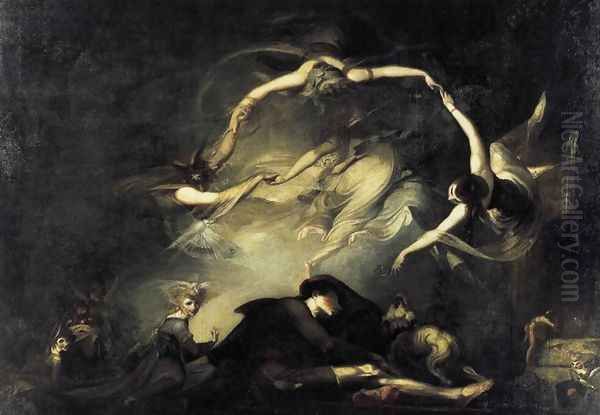
His breakthrough came in 1782 when he exhibited The Nightmare at the annual Royal Academy exhibition. The painting caused an immediate sensation. It depicts a sleeping woman, draped languidly across a bed, with a demonic incubus crouching menacingly on her chest. Peering from behind a curtain in the background is the spectral head of a horse with eerie, white eyes. The subject matter – exploring themes of sexuality, fear, and the subconscious – was shocking and unprecedented for its time. Its blend of horror, eroticism, and dreamlike ambiguity captivated and disturbed audiences in equal measure.
The Nightmare became one of the most talked-about and reproduced images of its era. Its success cemented Fuseli's reputation as a highly original, if controversial, artist. Interpretations abounded: some saw it as an exploration of sleep paralysis or the effects of nightmares, while others offered biographical readings. One persistent interpretation connects the painting to Fuseli's unrequited passion for Anna Landolt, a woman he had met in Zurich whom he could not marry. According to his friend Lavater, Fuseli dreamt of the painting's composition the night he learned of her marriage to another man, suggesting the work might channel his frustrated desires and jealousy. Regardless of its specific origins, The Nightmare tapped into a growing fascination with the irrational, the Gothic, and the darker aspects of human experience, becoming an iconic image of the Romantic era. Fuseli painted several versions of this highly popular subject.
The Fuseli Style: Drama, Literature, and the Sublime
Johann Henry Fuseli's artistic style is one of the most distinctive and recognizable of his time, standing apart from the prevailing Neoclassicism exemplified by artists like Jacques-Louis David in France. While Fuseli possessed a deep knowledge of classical art and literature, his interpretation was filtered through a lens of intense emotionalism, theatricality, and a fascination with the extreme. His work is a cornerstone of Romanticism, particularly its darker, more psychological vein, often referred to as the "Gothic" or the exploration of the "Sublime."
Central to Fuseli's style is his emphasis on the human figure, often depicted with exaggerated anatomy – elongated limbs, powerful musculature (clearly indebted to Michelangelo), and contorted, dynamic poses that convey intense emotion or physical strain. He prioritized dramatic effect over naturalistic representation. His compositions are frequently theatrical, employing stark contrasts of light and shadow (chiaroscuro) to heighten the sense of mystery, horror, or divine intervention. Linearity is also key; his figures are often defined by strong, energetic outlines, reflecting his belief, shared with William Blake, that drawing was the foundation of art.
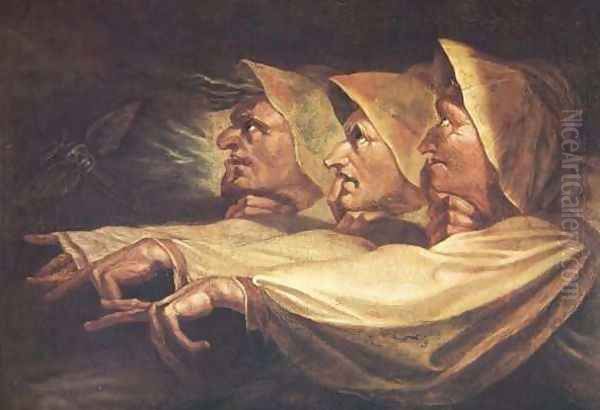
Fuseli drew heavily on literary sources for his subjects, finding inspiration in the epic grandeur and psychological depth of Homer, Dante's Inferno, and particularly the works of English poets John Milton (Paradise Lost) and William Shakespeare. He sought out moments of high drama, supernatural encounters, and intense psychological conflict – witches' prophecies, ghostly apparitions, heroic struggles, and tormented dreams. He aimed to evoke the Sublime, an aesthetic concept referring to experiences that inspire awe, terror, and a sense of being overwhelmed by forces larger than oneself. His exploration of dreams, nightmares, and the supernatural prefigured later interests in psychoanalysis and Surrealism.
The Shakespeare Gallery and Literary Illustrations
Fuseli's deep engagement with literature found a significant outlet in large-scale public projects and book illustrations. His ability to translate complex literary narratives and psychological states into powerful visual images made him a sought-after contributor, particularly for subjects demanding imagination and dramatic flair. One of the most notable projects he was involved in was Alderman John Boydell's Shakespeare Gallery.
Launched in 1786, Boydell's ambitious enterprise aimed to foster a school of British history painting by commissioning leading artists to create large paintings based on Shakespeare's plays. These paintings were exhibited in a dedicated gallery in Pall Mall and subsequently engraved and published in a lavish illustrated edition of Shakespeare's works. Fuseli was a major contributor, producing eight large canvases and one smaller work for the gallery. His contributions, including dramatic scenes like Titania and Bottom from A Midsummer Night's Dream and Hamlet and the Ghost, were among the most striking and imaginative in the collection, showcasing his signature style of exaggerated forms and heightened emotion.
Beyond the Shakespeare Gallery, Fuseli dedicated significant effort to illustrating John Milton's Paradise Lost. He considered Milton a kindred spirit, drawn to the epic scope, theological drama, and sublime imagery of the poem. Fuseli even planned his own "Milton Gallery" project, intended to rival Boydell's Shakespeare Gallery, although it was less commercially successful. He produced numerous powerful drawings and paintings depicting scenes of Satan's fall, the temptation of Adam and Eve, and celestial battles. His illustrations for Milton, Shakespeare, Dante, and other literary works were widely disseminated through engravings, significantly contributing to his fame and influence both in Britain and on the continent.
Fuseli at the Royal Academy: Professor and Keeper
Fuseli's growing reputation and distinctive artistic vision earned him recognition within Britain's foremost artistic institution, the Royal Academy of Arts in London. He was elected an Associate Member (ARA) in 1788 and became a full Academician (RA) in 1790. His involvement with the Academy deepened significantly over the following years, culminating in influential teaching and administrative roles.
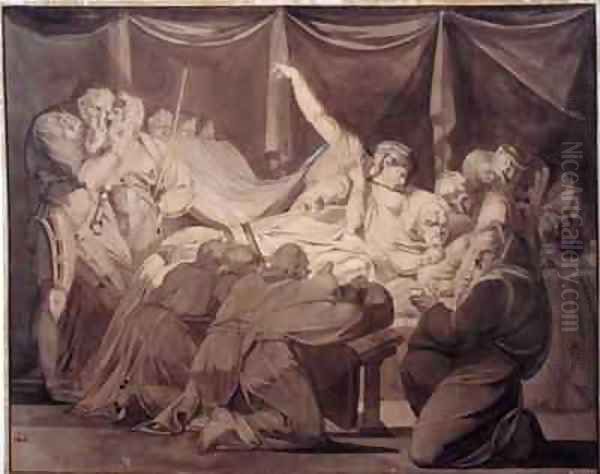
In 1799, Fuseli was appointed Professor of Painting at the Royal Academy. In this capacity, he delivered a series of lectures on the history and theory of art, which were highly regarded for their erudition, insightful analysis, and passionate delivery. These Lectures on Painting, later published, articulated his artistic philosophy, emphasizing the importance of imagination, the study of masters like Michelangelo, and the pursuit of the "grand style." He championed historical and poetic subjects over mere imitation of nature, advocating for art that engaged the intellect and emotions. His lectures influenced a generation of students and fellow artists.
In 1804, while retaining his professorship, Fuseli was also elected Keeper of the Royal Academy. This prestigious position effectively made him the head of the Royal Academy Schools, responsible for overseeing the students' training and the institution's collection of casts and artworks. He held this dual role until his death in 1825 (with a brief interruption when he resigned the professorship between 1805 and 1810). As Keeper, he was a formidable presence, known for his vast knowledge and demanding standards. Among the many students who passed through the RA Schools during his tenure and were likely influenced by his teaching or presence were notable figures such as Edwin Landseer, William Etty, Charles Robert Leslie, and Benjamin Robert Haydon. His long tenure solidified his position as a central figure in the British art establishment.
Relationships and Character
Johann Henry Fuseli was known as a man of formidable intellect, sharp wit, and strong opinions. Contemporaries described him as learned, fluent in multiple languages, and capable of brilliant conversation, but also as eccentric, arrogant, impatient, and sometimes difficult to deal with. His personality was as dramatic and intense as his artwork. He possessed a fiery temper and did not suffer fools gladly, often making biting remarks about fellow artists whose work he disdained.
Throughout his life, he maintained important friendships. His early bond with Johann Kaspar Lavater endured despite their geographical separation, maintained through correspondence. In London, Sir Joshua Reynolds provided crucial early mentorship. He was also part of a radical intellectual circle in London that included the political philosopher William Godwin and the pioneering feminist writer Mary Wollstonecraft. Fuseli developed a strong, albeit unreciprocated, infatuation with Wollstonecraft, even proposing a platonic ménage à trois with her and her husband, which was firmly rejected. In 1788, Fuseli married Sophia Rawlins, who often served as a model for his figures, though little is known about their personal dynamic.
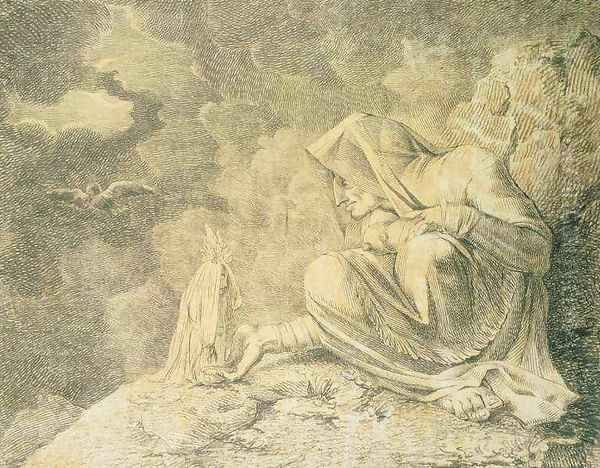
Fuseli's interest in the supernatural, evident in his art, seems to have extended into his personal beliefs. His connection with Lavater, who was deeply interested in physiognomy and spiritualism, likely fueled this inclination. Fuseli reportedly believed in ghosts and was fascinated by folklore, witchcraft, and dreams, seeing them as valid sources of artistic inspiration, perhaps even channels for a form of "divine inspiration." His complex character – a blend of classical erudition, Romantic passion, intellectual rigor, and a penchant for the bizarre – mirrored the unique synthesis found in his art. Indirect connections existed with figures like Goethe, through shared acquaintances, and Lord Byron, whose dark Romanticism shared some affinities with Fuseli's themes.
Legacy and Influence
Johann Henry Fuseli's impact on the course of art history is significant and multifaceted. During his lifetime, he was a celebrated yet controversial figure, recognized for his powerful imagination and technical skill, particularly in drawing. He played a crucial role in shaping British Romanticism, offering a darker, more psychologically intense alternative to the landscape focus of artists like J.M.W. Turner and John Constable. His influence is most clearly seen in the work of William Blake, who admired Fuseli greatly, sharing his emphasis on linearity, imagination, and literary inspiration, though Blake developed his own unique mystical cosmology.
After his death in 1825, Fuseli's reputation waned during the mid-19th century, as Victorian tastes shifted towards greater naturalism and moral didacticism. His exaggerated style and often disturbing subject matter fell out of favour. However, his work experienced a significant revival in the early 20th century. The Symbolists, such as Gustave Moreau and Odilon Redon, recognized him as a precursor in their exploration of dreams, myths, and subjective states. Later, the Surrealists, including Max Ernst and Salvador Dalí, hailed him as a forerunner for his pioneering depictions of the subconscious, irrational fears, and dream imagery, particularly embodied in The Nightmare. Expressionist artists also found resonance in the emotional intensity and distorted forms of his work.
Today, Fuseli is firmly established as a major figure of the Romantic era and a highly original artist whose work transcended easy categorization. He is valued for his unique synthesis of Neoclassical learning and Romantic sensibility, his profound engagement with literature, and his daring exploration of the human psyche's darker territories – themes of terror, desire, madness, and the supernatural. His Lectures on Painting remain important documents of art theory from the period. Artists like John Martin, known for his sublime and apocalyptic scenes, also show affinities with Fuseli's dramatic vision. His legacy lies in his expansion of art's subject matter and expressive range, paving the way for later movements that delved into the inner world of human experience.
Conclusion

Johann Henry Fuseli remains a compelling and enigmatic figure in the annals of art history. A Swiss expatriate who became a pillar of the British art establishment, he navigated the transition from Neoclassicism to Romanticism with a uniquely intense and personal vision. His deep immersion in classical and modern literature, combined with an imagination drawn to the dramatic, the terrifying, and the sublime, resulted in a body of work that continues to shock, fascinate, and provoke. From the iconic horror of The Nightmare to his powerful interpretations of Shakespeare and Milton, Fuseli pushed the boundaries of artistic expression, prioritizing psychological depth and imaginative power over mere verisimilitude. As an influential teacher and theorist at the Royal Academy, he shaped a generation of artists, while his own works foreshadowed later explorations of the subconscious in Symbolism, Expressionism, and Surrealism. Fuseli's enduring legacy rests on his creation of unforgettable images that probe the limits of human experience and the depths of the irrational mind, securing his place as a true master of the sublime and the supernatural.